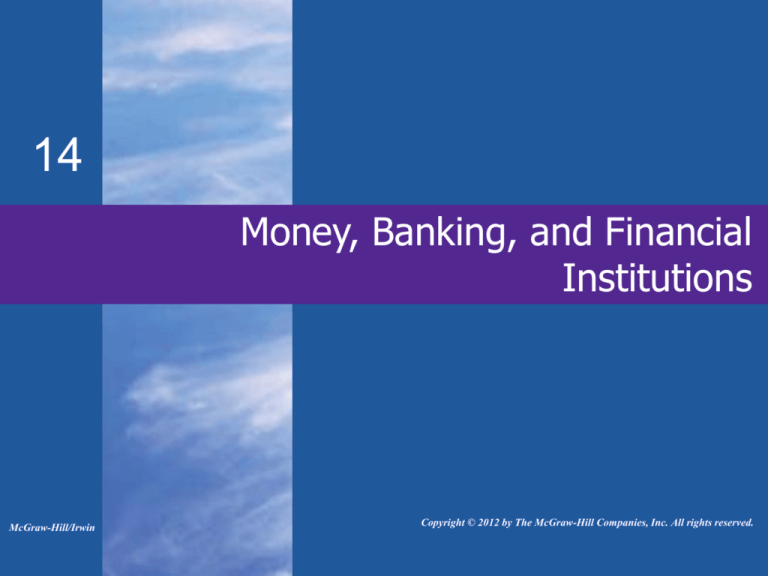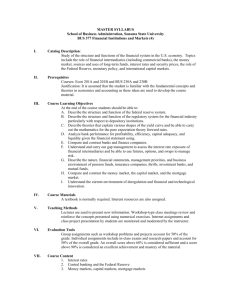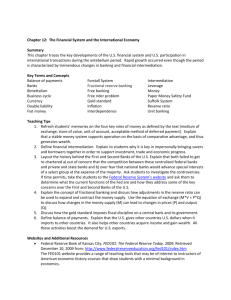
14
Money, Banking, and Financial
Institutions
McGraw-Hill/Irwin
Copyright © 2012 by The McGraw-Hill Companies, Inc. All rights reserved.
Functions of Money
• Medium of exchange
• Used to buy/sell goods
• Unit of account
• Goods valued in dollars
• Store of value
• Hold some wealth in money form
• Money is liquid
LO1
14-2
Money Definition M1
• M1
• Currency
• Checkable deposits
• Institutions offering checkable deposits
• Commercial banks
• Savings and loan associations
• Mutual savings banks
• Credit unions
LO1
14-3
Money Definition M2
• M2
• M1 plus near-monies
• Savings deposits including money
market deposit accounts (MMDA)
• Small-denominated time deposits
• Money market mutual funds
(MMMF)
LO1
14-4
Money Definitions
January 2010
Source: Federal Reserve System
LO1
14-5
What “Backs” the Money Supply?
• Guaranteed by government’s ability to
•
•
LO2
keep value stable
Money as debt
Why is money valuable?
• Acceptability
• Legal tender
• Relative scarcity
14-6
What “Backs” the Money Supply?
• Prices affect purchasing power of
•
•
LO2
money
Hyperinflation renders money
unacceptable
Stabilizing money’s purchasing power
• Intelligent management of the money
supply – monetary policy
• Appropriate fiscal policy
14-7
Federal Reserve - Banking System
• Historical background
• Board of Governors
• 12 Federal Reserve Banks
• Serve as the central bank
• Quasi-public banks
• Banker’s bank
LO3
14-8
Federal Reserve – Banking System
Board of Governors
Federal Open Market Committee
12 Federal Reserve Banks
Commercial Banks
Thrift Institutions
(Savings and Loan Associations,
Mutual Savings Banks,
Credit Unions)
The Public
(Households and
Businesses)
LO3
14-9
Federal Reserve – Banking System
The 12 Federal Reserve Banks
LO3
14-10
Federal Reserve – Banking System
• Federal Open Market Committee
• Aids Board of Governors in
•
LO3
setting monetary policy
• Conducts open market
operations
Commercial banks and thrifts
• 6,800 commercial banks
• 8,700 thrifts
14-11
Federal Reserve Functions
• Issue currency
• Set reserve requirements
• Lend money to banks
• Collect checks
• Act as a fiscal agent for U.S.
•
•
LO4
government
Supervise banks
Control the money supply
14-12
Federal Reserve Independence
• Established by Congress as an
•
•
LO4
independent agency
Protects the Fed from political
pressures
Enables the Fed to take actions to
increase interest rates in order to
stem inflation as needed
14-13
Financial Institutions
World’s 12 Largest Financial Institutions, 2009
0
Assets (Trillions of U.S. Dollars)
1.5
2.5
3.5
Royal Bank of Scotland (UK)
Barclays (UK)
Deutsche Bank (Germany)
BNP Paribas (France)
HSBC Holdings (UK)
JPMorgan Chase (US)
Credit Agricole (France)
Citigroup (US)
Mitsubishi UFJ (Japan)
UBS (Switzerland)
ING Group (Netherlands)
Bank of America (US)
Source: Forbes Global 2000, http://www.forbes.com
LO4
14-14
The Financial Crisis of 2007 and 2008
• Mortgage Default Crisis
• Many causes
• Government programs that
encouraged home ownership
• Declining real estate values
• Bad incentives provided by
mortgage-backed bonds
LO5
14-15
The Financial Crisis of 2007 and 2008
• Securitization- the process of slicing
•
•
LO5
up and bundling groups of loans into
new securities
As loans defaulted, the system
collapsed
“Underwater” homeowners
abandoned homes and mortgages
14-16
The Financial Crisis of 2007 and 2008
• Failures and near-failures of financial
•
LO5
firms
• Countrywide: second largest lender
• Washington Mutual: largest lender
• Wachovia
Other firms came close
14-17
The Financial Crisis of 2007 and 2008
• Troubled Asset Relief Program
(TARP)
• Allocated $700 billion to make
emergency loans
• Saved several institutions from failure
LO6
14-18
The Financial Crisis of 2007 and 2008
• The Fed’s lender-of-last-resort
activities
• Primary Dealer Credit Facility
• Term Securities Lending Facility
• Asset-Backed Commercial Paper
Money Market Mutual Fund
Liquidity Facility
• Commercial Paper Funding Facility
LO6
14-19
The Financial Crisis of 2007 and 2008
• Money Market Investor Funding
Facility
• Term Asset-Backed Securities Loan
Facility
• Interest Payments on Reserves
LO6
14-20
Post-Crisis U.S. Financial Services
• Major Categories of Financial
Institutions
• Commercial Banks
• Thrifts
• Insurance Companies
• Mutual Fund Companies
• Pension Funds
• Securities Firms
• Investment Banks
LO7
14-21
Major Categories of Financial Institutions
LO7
Institution
Description
Examples
Commercial Banks
State and national banks that provide checking and savings
accounts and make loans
JP Morgan Chase, Bank
of America, Citibank,
Wells Fargo
Thrifts
Savings and loan associations, mutual savings banks, credit
unions that offer checking and savings accounts and make
loans
Charter One, New York
Community Bank
Insurance
Companies
Firms that offer policies through which individuals pay
premiums to insure against lose
Prudential, New York
Life, Northwestern
Mutual, Hartford
Mutual Fund
Companies
Firms that pool customer deposits to purchase stocks or
bonds
Fidelity, Vanguard,
Putnam, Janus, T Rowe
Price
Pension Funds
Institutions that collect savings from workers throughout their
working years and then invest the funds to pay retirement
benefits
TIAA-CREF, Teamsters’
Union, CalPERs
Securities Firms
Firms that offer security advice and buy and sell stocks and
bonds for clients
Merrill Lynch, Smith
Barney, Charles Schwab
Investment Banks
Firms that help corporations and governments raise money by
selling stocks and bonds
Goldman Sachs, Morgan
Stanley, Deutsche Bank,
Nomura Securities
14-22
Post-Crisis U.S. Financial Services
• Wall Street Reform and Consumer
Protection Act
• Passed to help prevent many of the
practices that led to the crisis
• Critics say it adds heavy regulatory
costs
LO7
14-23
Electronic Banking
• Electronic-based payment systems
have pushed aside currency and
checks
• Credit/debit cards
• Fedwire transfers
• ACH transactions
• Electronic money
• Stored-value cards
14-24








